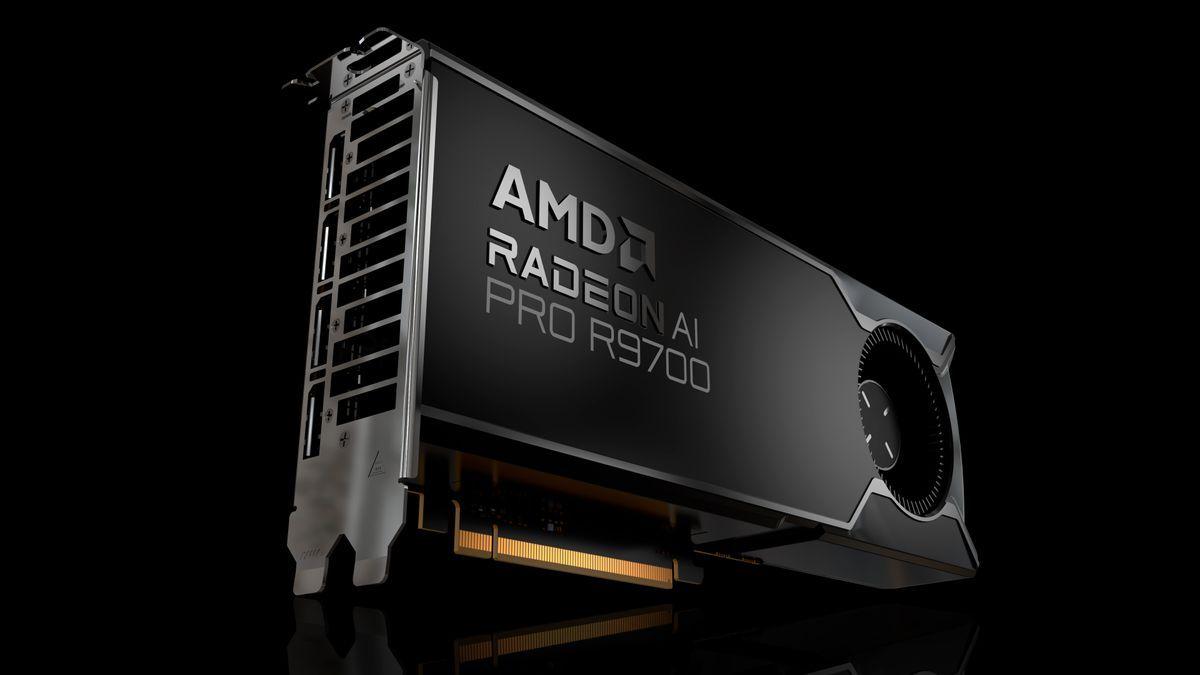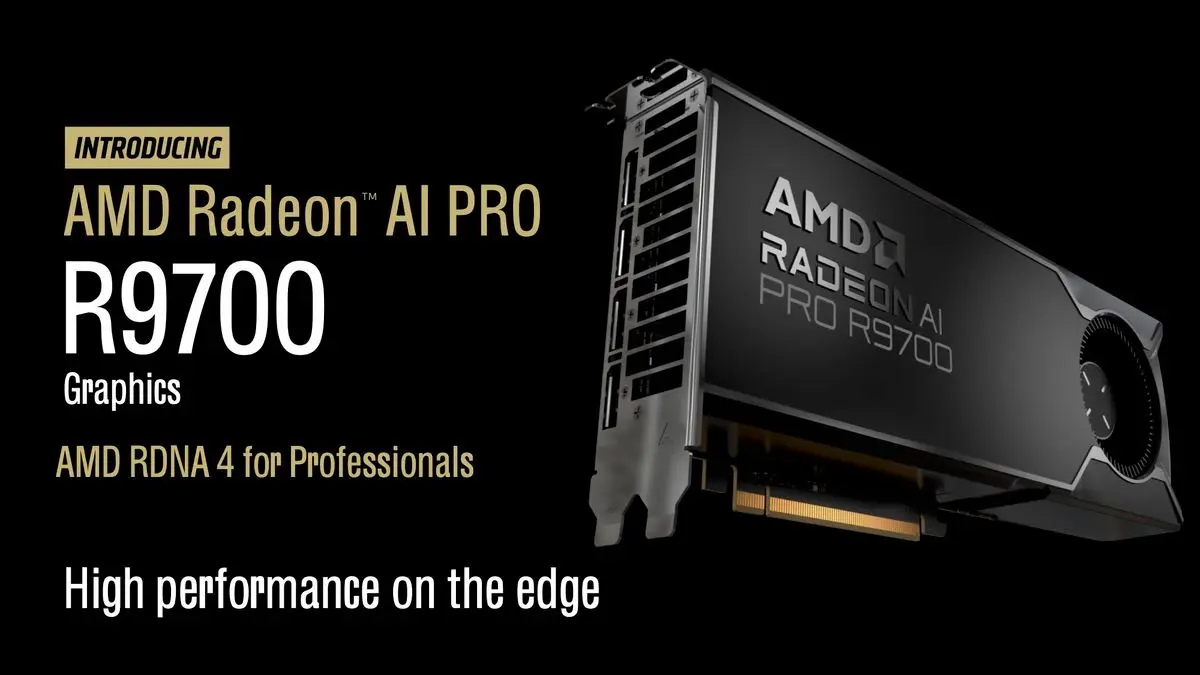AMD Unveils Radeon AI PRO R9700: A Powerful GPU for AI and Workstation Users
3 Sources
3 Sources
[1]
ASRock preps Radeon RX AI Pro R9700 Creator for AI and workstation users -- blower card adopts 16-pin connector, features 300W TBP rating
AMD's Radeon AI Pro R9700 may not be a contender for inclusion on the list of best graphics cards for gaming. Nevertheless, the professional PCIe 5.0 graphics card powered by Navi 48 presents an excellent option for the AI and workstation sectors; consequently, ASRock has promptly introduced the brand's Radeon RX AI Pro R9700 Creator, which is based on the reference Radeon AI Pro R9700. The Radeon RX AI Pro R9700 Creator is the third installment in ASRock's Creator lineup of graphics cards, succeeding the previous Radeon RX 7900 XTX Creator and Radeon RX 7900 XT Creator. Design-wise, you can never go wrong with a dual-slot design and a blower-type cooling system, a combination that facilitates multi-GPU setups on a single motherboard. ASRock implemented a vapor chamber under the Radeon RX AI Pro R9700 Creator's die-cast metal shroud. It also uses Honeywell PTM7950 phase-changing thermal pads for improved heat dissipation. The Radeon RX AI Pro R9700 Creator, equipped with the Navi 48 silicon, boasts 4,096 Streaming Processors (SPs) and achieves game and boost clock speeds of up to 2,350 MHz and 2,920 MHz, respectively. These clock speeds align with the reference specifications. One key attraction for AI and workstation users is the Radeon RX AI Pro R9700 Creator's memory capacity. This graphics card has 32GB of GDDR6 memory running at 20 Gbps. Additionally, its 256-bit memory interface allows for a memory bandwidth of up to 644.6 GB/s. The Radeon RX AI Pro R9700 Creator features a Total Board Power (TBP) of 300W, requiring external power through a single 12V-2x6 power connector. While this may seem excessive, professional-grade graphics cards are increasingly adopting the 12V-2x6 power connector. ASRock advises using a power supply of at least 800W from a reliable brand for the Radeon RX AI Pro R9700 Creator. The Radeon RX AI Pro R9700 Creator is 10.7 inches (271mm) long, but it's recommended to have an extra 1.2 inches (30mm) space in your case to accommodate the power cable. You know how picky the 12V-2x6 power cable can be with bending. The Radeon RX AI Pro R9700 Creator allows connection of up to four displays. However, the options are limited since it only offers DisplayPort 1.2a outputs. These outputs, nonetheless, support resolutions up to 8K (7680x4320), which are more than sufficient for professional users. The Radeon AI Pro R9700 launches in July, so the Radeon RX AI Pro R9700 Creator and iterations from other brands will also be available then. Like AMD, ASRock didn't share the pricing for the Radeon RX AI Pro R9700 Creator.
[2]
ASRock unveils Radeon RX AI PRO R9700 Creator: workstation GPU with 32GB VRAM, 12V-2x6 power
As an Amazon Associate, we earn from qualifying purchases. TweakTown may also earn commissions from other affiliate partners at no extra cost to you. ASRock has just unveiled its new Radeon AI PRO R9700 Creator graphics card, based on the PRO R9700 GPU that the company launched earlier this week. The new ASRock AI PRO R9700 Creator graphics card is aimed at both edge AI acceleration and professional visualization markets, and it's based on the Navi 48 GPU on TSMC's new 4nm process node, meaning the GPU has its maxed-out specs including all 64 CUs with 4096 stream processors, 128 AI accelerators, and 64 RT accelerators. The big difference between the gaming-focused Radeon RX 9070 XT and PRO R9700 is that the workstation GPU features 32GB of GDDR6 memory versus 16GB on the gaming GPU. VRAM helps out with AI workloads, so with double the GDDR6 memory, the new ASRock Radeon AI PRO R9700 Creator is geared and ready to go for higher-end workloads. Another interesting design choice from ASRock is the Radeon AI PRO R9700 Creator's slimmer dual-slot form factor and a blower-style cooling design, as well as the newer 16V-2x6 power connector. We've also got the blower-style cooler using cutouts behind the blower, as well as the clearance of the backplate towards the tail-end that helps with airflow to other cards in the system. This is the second time that ASRock has used this design during this generation, as the company used the same method with its higher-end Radeon RX 9070 XT Taichi graphics card. The connector is also located at the end of the card and not at the top, as it allows the new ASRock Radeon AI PRO R9700 Creator to be used in 3U rackmount chassis installations, something that can't be done with top-oriented power inputs, an important step when using the 12V-2x6 connector with its strict cable bending restrictions. ASRock's new Radeon AI PRO R9700 Creator measures in at 27.1 cm long and 11.1 cm tall, with 4 x DisplayPort 2.1a connectors.
[3]
AMD Radeon AI PRO R9700 GPU Offers 4x More TOPS & 2x More AI Performance Than Radeon PRO W7800
AMD has shared more details about its Radeon AI PRO R9700 GPU and how it compares in AI tasks against the existing Radeon PRO W7800. AMD recently expanded its software suite with ROCm 7, with its current AI accelerator strategy scaling across three main categories: the Ryzen AI MAX APUs, aiming at Small-Medium LLMs, the Radeon AI PRO GPUs, aiming the Multi-GPU Edge inference & small-medium LLMs, and lastly, the Instinct AI accelerators, aiming at Large LLMs for Rack Scale Inference, and training. While AMD has detailed its MI350 series, the company also revealed some more AI statistics for its Radeon AI PRO lineup. The AMD Radeon AI PRO R9700 uses the Navi 48 GPU, which comes with 64 compute units or 4096 stream processors. The GPU is loaded with 128 AI accelerators and has a TBP of up to 300W. In terms of memory, the AMD Radeon AI PRO R9700 is equipped with 32 GB of GDDR6 memory, running across a 256-bit bus, and this essentially doubles the VRAM featured on the 9070 XT. Other performance aspects being shared by AMD include the 96 TFLOPs of FP16 compute and 1531 TOPS INT4 (Sparse). The goal of the AMD Radeon AI PRO R9700 GPU is to enable high-quality AI models to be completed efficiently. That's why it has been equipped with 32 GB of VRAM, which is an optimal amount for most advanced Local AI workloads, such as DeepSeek R1 Distill Qwen 32B Q6, Mistral Small 3.1 24B Instruct 2503 Q8, Flux 1 Schnel, and SD 3.5 Medium. As for performance, AMD states that the Radeon AI PRO R9700 is twice as fast as the Radeon PRO W7800 32 GB GPU in DeepSeek R1, while the company also shows a few measurements against the RTX 5080, which features a 16 GB VRAM buffer. The 16 GB of VRAM might not be suitable for AI models that require more memory, and that's why the R9700 is being shown to be up to 5x faster. Diving into the compute metrics, the R9700 will offer 47.8 TFLOPs of FP32, 191.4 TFLOPs of FP16 / BF16, 382.7 TFLOPs of FP8, 382.7 TOPs of INT8, and 765.5 TOPS of INT4 performance. The GPU will also support Wave Matrix Multiply Accumulate (WMMA) instructions and Structured Sparsity. With Sparsity, the total INT4 TOPS will reach 1531. The FP16 figures are a 2x increase over the Radeon PRO W7800, while the INT8/INT4 figures see a 4x uplift. AMD also highlights why having support for larger models is essential for obtaining better results. In Text-To-Image, an 8B model run on FP16 will produce far better results than a 1B model. As for reasoning, a 32B 6-bit model will produce higher accuracy than an 8B 6-bit model. AMD also showcases the FP16 AI performance in a single GPU comparison between the R9700 & the W7800, with the new variant offering over 2x performance uplift in DeepSeek R1 Distill Llama (8B). But it doesn't end here; the AMD Radeon AI PRO R9700 can also be scaled in 4-way Multi-GPU configurations using a modern-day PCIe 5.0 platform. This enables users to harness a massive 128 GB pool, which can handle buffer models such as Mistral 123B & DeepSeek R1 70 B. These models can consume up to 112-116 GB of VRAM. Lastly, for availability, the AMD Radeon AI PRO R9700 GPU will be available in July this year through leading partners such as ASUS, ASRock, Gigabyte, PowerColor, Sapphire, XFX, and Yeston. The card is going to be a dual-slot design with a blower cooler.
Share
Share
Copy Link
AMD introduces the Radeon AI PRO R9700, a high-performance GPU designed for AI and professional workloads, offering significant improvements in AI processing capabilities and memory capacity.
AMD Introduces Radeon AI PRO R9700 for AI and Professional Markets
AMD has unveiled its latest graphics card, the Radeon AI PRO R9700, targeting the growing AI and professional workstation markets. This new GPU, based on the Navi 48 silicon and manufactured using TSMC's 4nm process, represents a significant leap in AMD's AI accelerator strategy
1
2
.Technical Specifications and Performance
The Radeon AI PRO R9700 boasts impressive specifications:
- 4,096 Streaming Processors (SPs)
- 128 AI accelerators and 64 RT accelerators
- Game and boost clock speeds up to 2,350 MHz and 2,920 MHz respectively
- 32GB of GDDR6 memory with a 256-bit interface, offering 644.6 GB/s bandwidth
- Total Board Power (TBP) of 300W
1
2
In terms of performance, AMD claims the R9700 delivers:
- 96 TFLOPs of FP16 compute
- 1531 TOPS INT4 (Sparse)
- 2x faster AI performance compared to the Radeon PRO W7800 in certain tasks
- Up to 5x faster performance in some scenarios compared to the NVIDIA RTX 5080 (16GB variant)
3
AI and Workstation Capabilities
The R9700 is designed to handle advanced Local AI workloads efficiently:
- Supports models like DeepSeek R1 Distill Qwen 32B Q6 and Mistral Small 3.1 24B Instruct 2503 Q8
- 32GB VRAM allows for larger AI models, crucial for improved results in text-to-image and reasoning tasks
- Can be scaled to 4-way Multi-GPU configurations, enabling a massive 128GB VRAM pool for handling buffer models such as Mistral 123B & DeepSeek R1 70B
3
Related Stories
Design and Cooling
ASRock's version, the Radeon RX AI Pro R9700 Creator, showcases some unique design choices:

Source: Tom's Hardware
- Dual-slot form factor with a blower-style cooling system
- Vapor chamber under a die-cast metal shroud
- Honeywell PTM7950 phase-changing thermal pads for improved heat dissipation
- 12V-2x6 power connector located at the card's end, suitable for 3U rackmount chassis installations
1
2
Market Positioning and Availability
The Radeon AI PRO R9700 is positioned to compete in the professional GPU market:
- Targets both edge AI acceleration and professional visualization sectors
- Offers 4x more TOPS and 2x more AI performance than the previous Radeon PRO W7800
- Will be available through partners including ASUS, ASRock, Gigabyte, PowerColor, Sapphire, XFX, and Yeston
- Scheduled for release in July 2023, with pricing yet to be announced
1
2
3
This release underscores AMD's commitment to expanding its presence in the AI hardware market, offering a compelling option for professionals and researchers working with AI models and high-performance computing tasks.
References
Summarized by
Navi
[1]
[2]
Related Stories
Recent Highlights
1
AI Chatbots Sway Voters More Effectively Than Traditional Political Ads, New Studies Reveal
Science and Research

2
OpenAI declares code red as Google's Gemini 3 gains 200 million users in three months
Technology

3
Trump approves Nvidia H200 chip exports to China with 25% revenue cut, defying Senate concerns
Policy and Regulation








